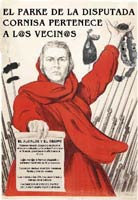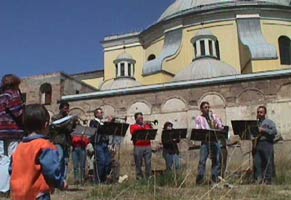|
|
|||||||||||||||||||||
FLAMENCO
SINGING AGAINST GENTRIFYING BISHOPS
La Fiambrera
It happened that our neighbors in Madrid were fighting the bishop and the mayor, because the latter had taken a nice, big piece of land, which was supposed to become a park for the people, and had just given it to the bishop for him to build some office blocks and several hundred underground private parking-lots. We discovered that there would be a "procession" in which the mayor and the bishop would be solemnly marching after the Virgin, in front of thousands of neighbors, of course protected by policemen nicely dressed in their "walking-out" uniforms. In Spain, whenever there is one of these processions with virgins, mayors, bishops and the like, it might happen that someone feeling really devoted to the virgin, goes up to a balcony and starts singing a "saeta," a flamenco song performed without a guitar, in which the "cantator" silences the audience just by the power of the voice.So we got a neighbor who was a flamenco singer to sing a slightly changed version of the traditional saeta just as the mayor and bishop were crossing in front of our threatened public domain. That day there were several thousand people in the streets, along with the expected TV cameras.
Our neighbor started to sing:
La viiirgen de la Palooomaaaaa
tiene el corason partiiiooooo...
(The Virgin de la Paloma,
has a broken heart (pause)By then every body was completely silent and full of devotion (singing those lines takes more than a minute); the bishop and the mayor were really impressed by all the popular religious feeling … but then their faces started to become red, and gradually white as they heard the second part of the saeta:
porque le han quitao el parqueeee
y oficinaas, le han metiiooo
(because they have robbed her park
and laid down offices there)Immediately everybody started laughing and calling them "chorizos", and the virgin started to run away, just like a jogging virgin.
Obviously, in this context, we could have maintained our role as "artists" (playing once again with representations and concepts of public space, privatization processes, etc,) and just organized a nice exhibition in some gallery for our friends, and eventually some curator or art critic would have discovered us as "engaged" artists... Or we could simply have come in the middle of the procession and started shouting and handing out pamphlets to everyone and surely getting the policemen to arrest us, thereby getting a reputation as really radical activists...
Somehow both options would not have been tactically justifiable. Neither one would have acknowledged the procession as the kind of thing that happens here as a political arena, as a space that can not only be appreciated but intervened in. The saeta intervention had a lasting and empowering effect on many of the neighbors, and it was good to get more people engaged whose religious feelings would have been immediately offended by any other kind of intervention in the procession, like handing out pamphlets.
If we consider the other options, namely the gallery show and the radical-activist gesture, for us the concept of tactics was important in choosing instead the saeta intervention … on two different levels. First, the saeta intervention taught us to develop a sense for the topology of tactics--to identify an arena which could be open for an intervention. Art galleries are usually spaces of representation rather than places where neighbors are present, and where conflicts can appear-places where tactics can be learned and practiced. As popular practices, processions are often being used for the negotiations of conflicts, so all we had to do was to look at the structure of popular tactics and play with them in our own way. Secondly, the saeta intervention was important in developing a methodology of the tactical approach-the "way of doing" which we should choose in the arena of conflict. The aesthetic evaluation was also significant: we judged that it would be more effective to use a really well sung saeta, instead of just throwing pamphlets. It is important to identify the arena of the procession as a place where politics might happen, but also to recognize the "popular" rituals that are part of such a procession as relevant to planning a political and aesthetic operation. This double character, the political and the aesthetic, had to be maintained. In fact, they reinforced each other. Methodologically, tactics would mean the appreciation of the saeta as an interesting media...
The theoretical definition of tactics, as constructed by De Certeau, remains for us an important tool, so long as it is not glorified abstractly and converted into a new excuse for scholars' meetings and academic conferences. The spaces where everyday politics can be found--and invented--are yet to be practically articulated, if we do not want to keep loosing all battles…
In this process of intervention, our role as "artists" was only that of a vanishing catalyst. While the saeta was being sung, a large group of neighbors began the process of organizing themselves: discussing the disputed piece of land, and how they would squat it, clean it, and open it to the public in the time to come. It was the beginning of the many weeks during which they created an illegal summer cinema.

